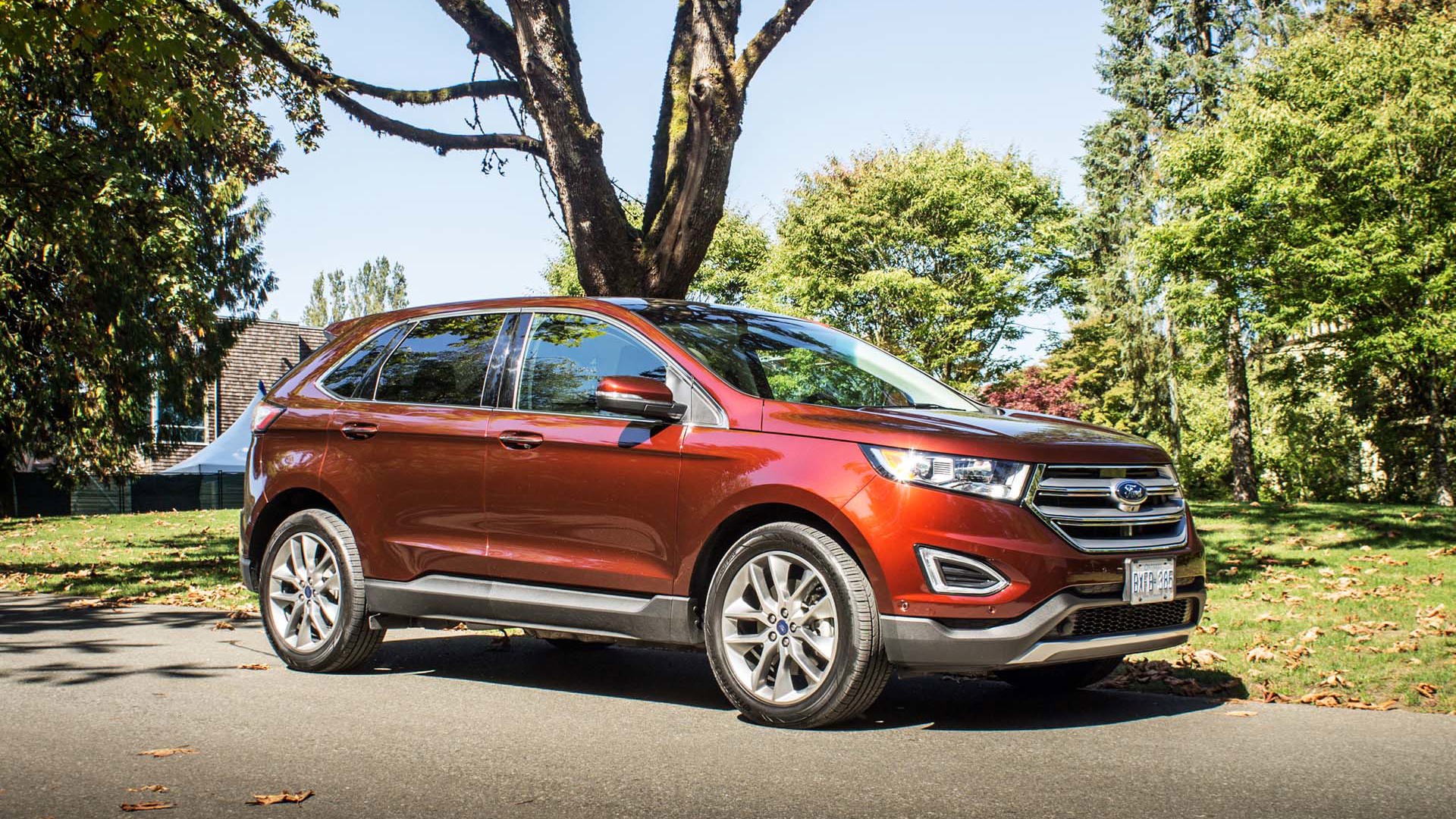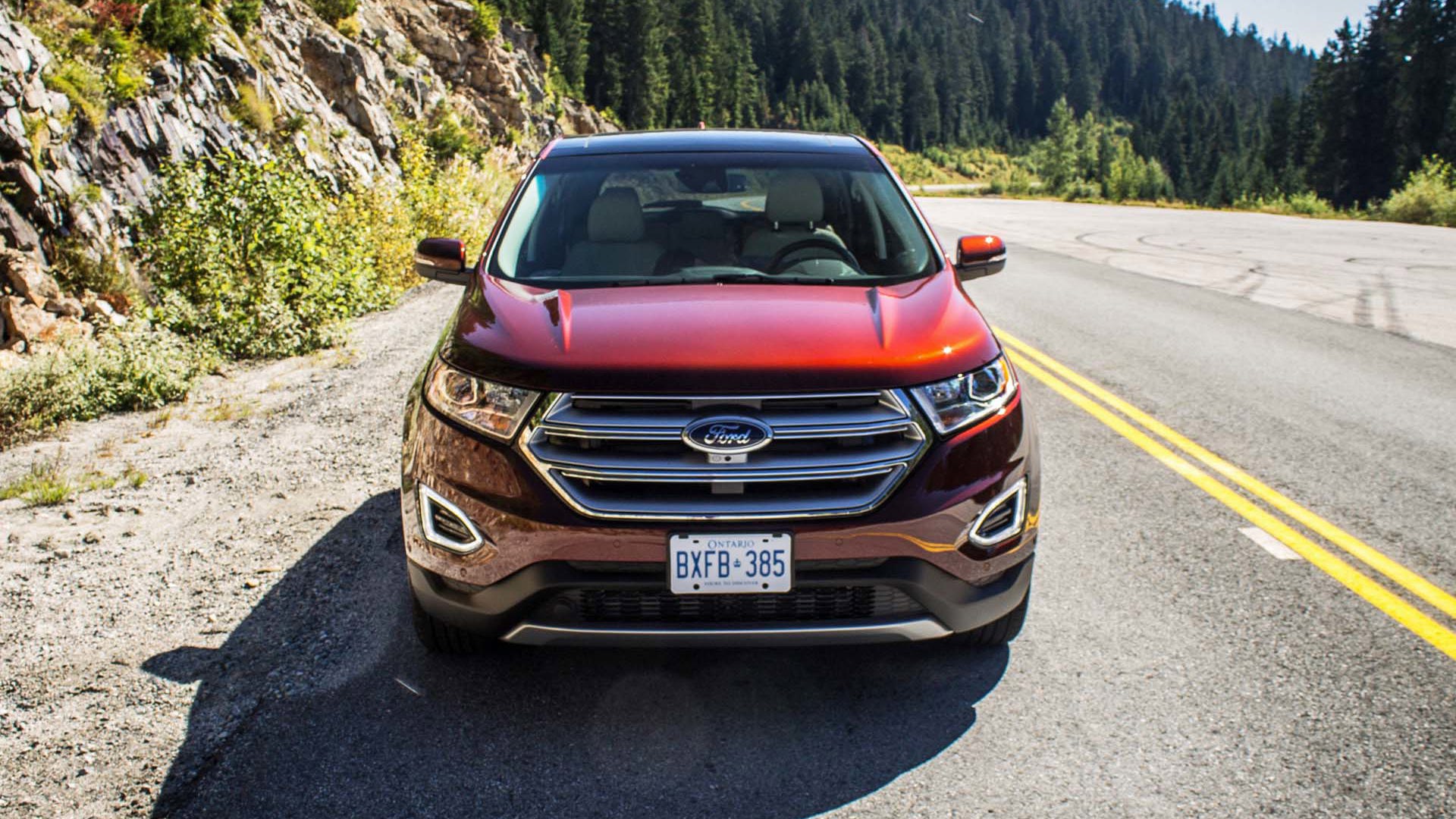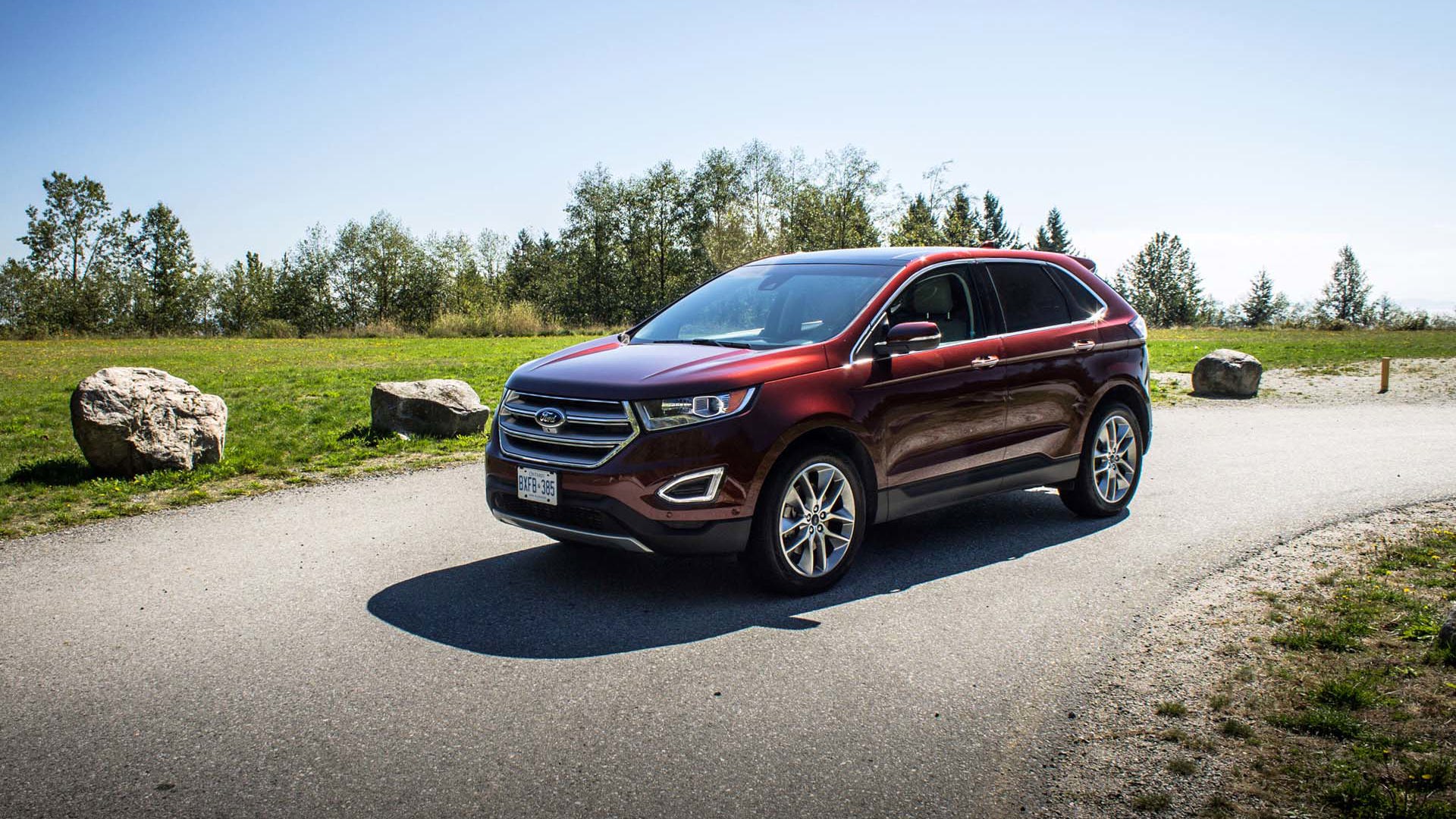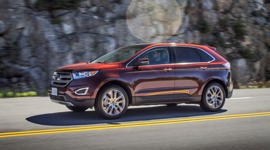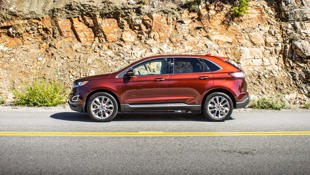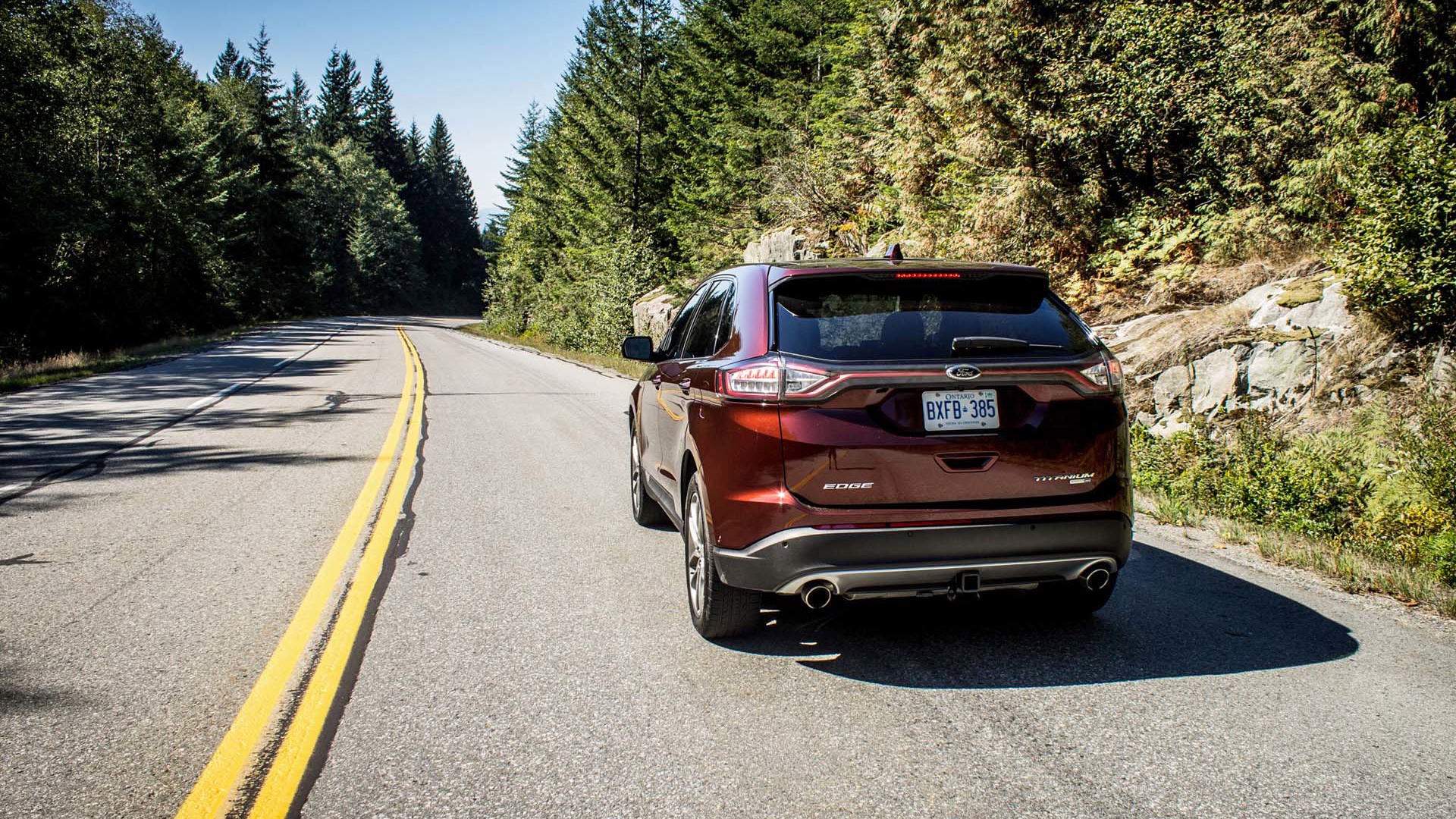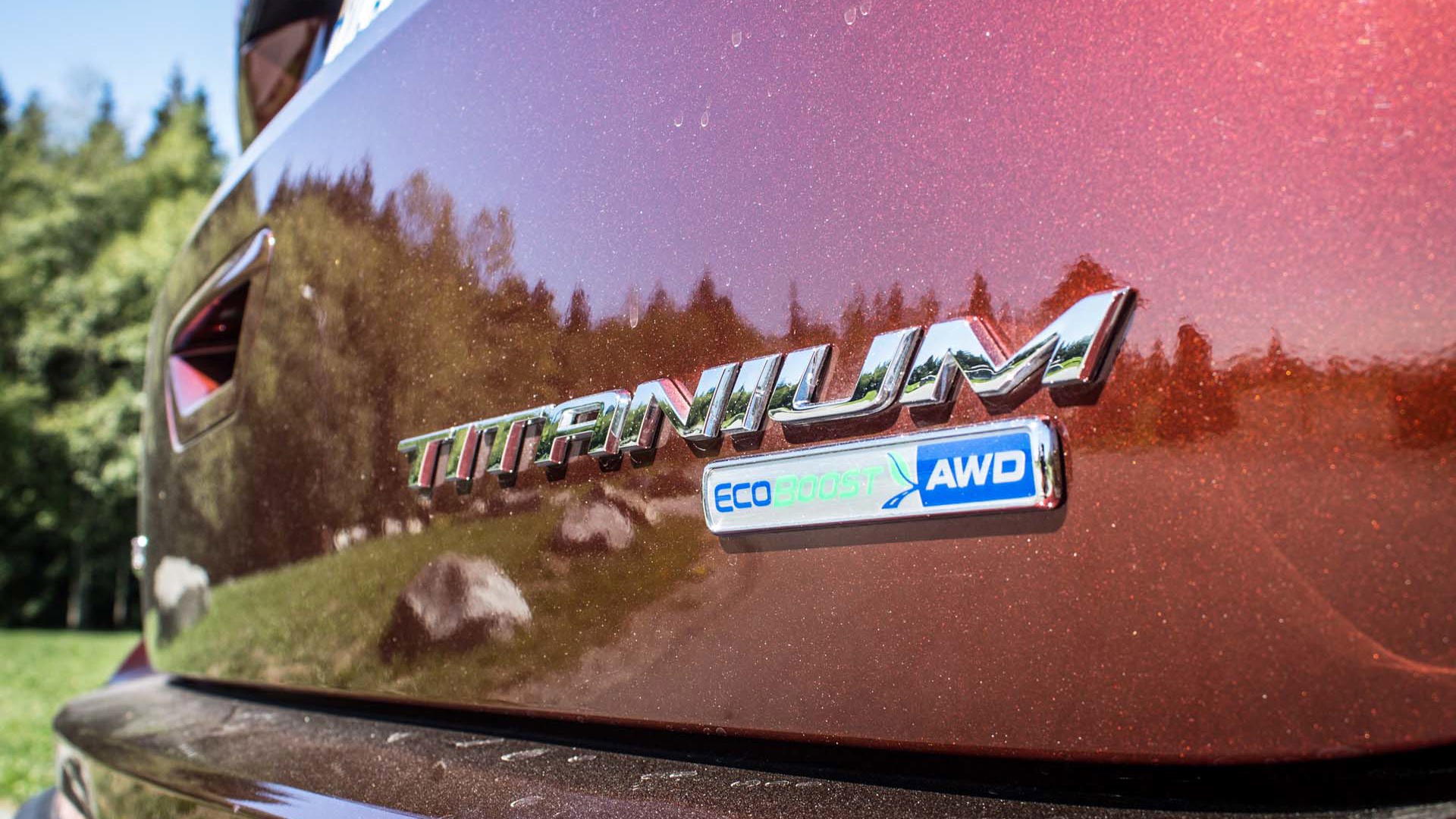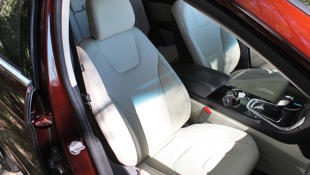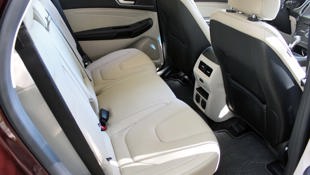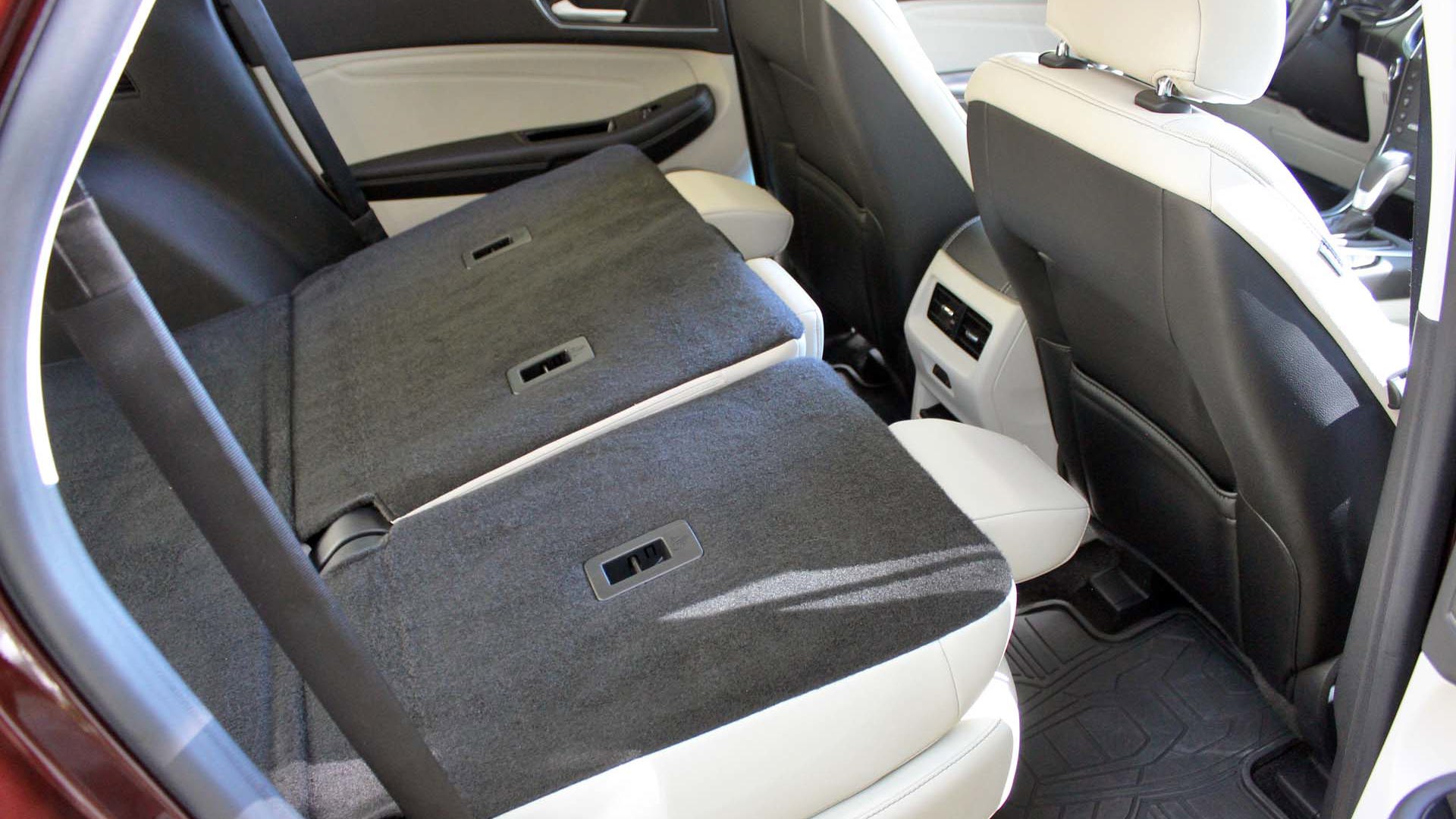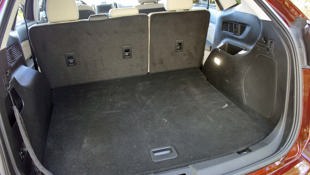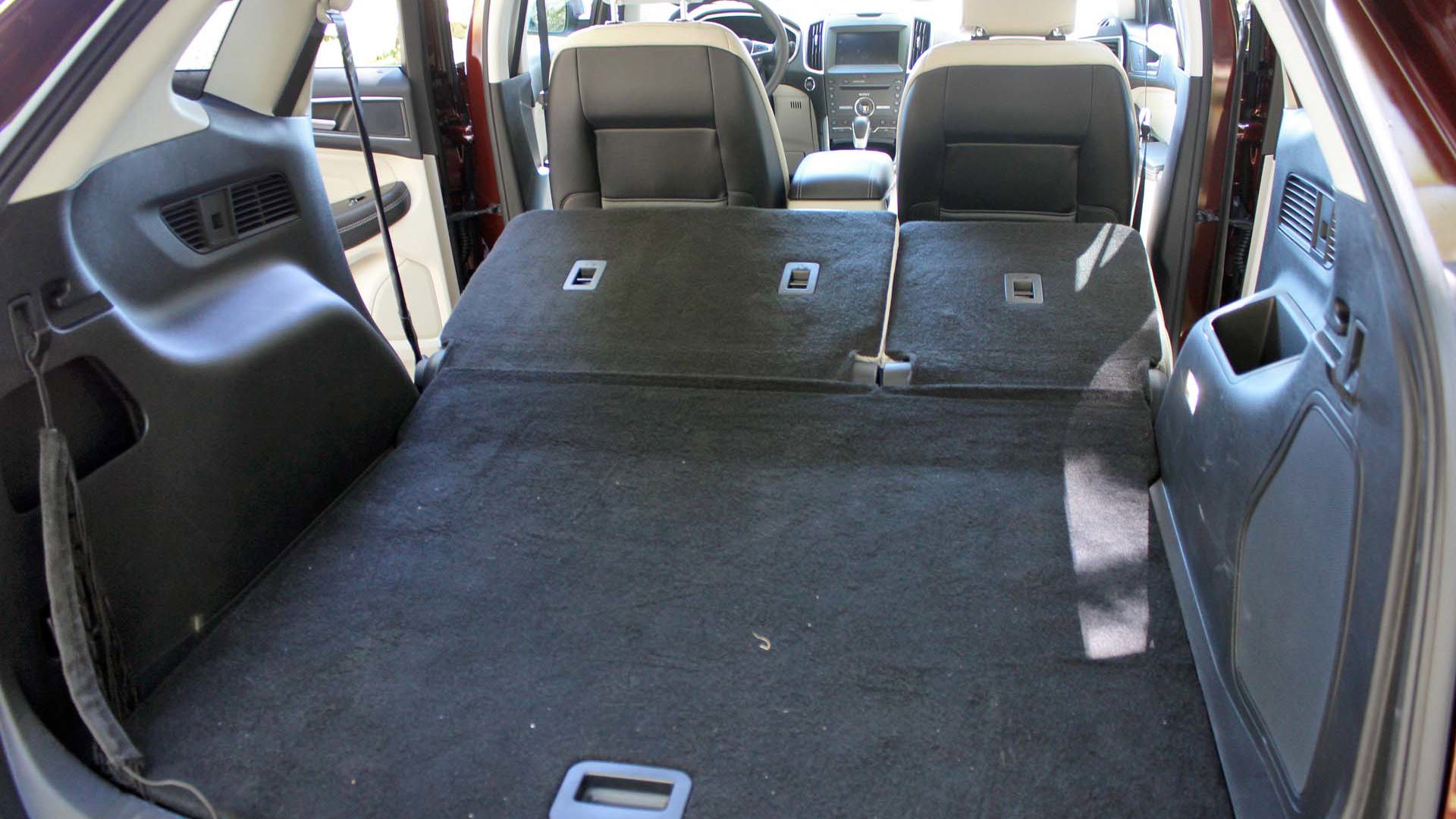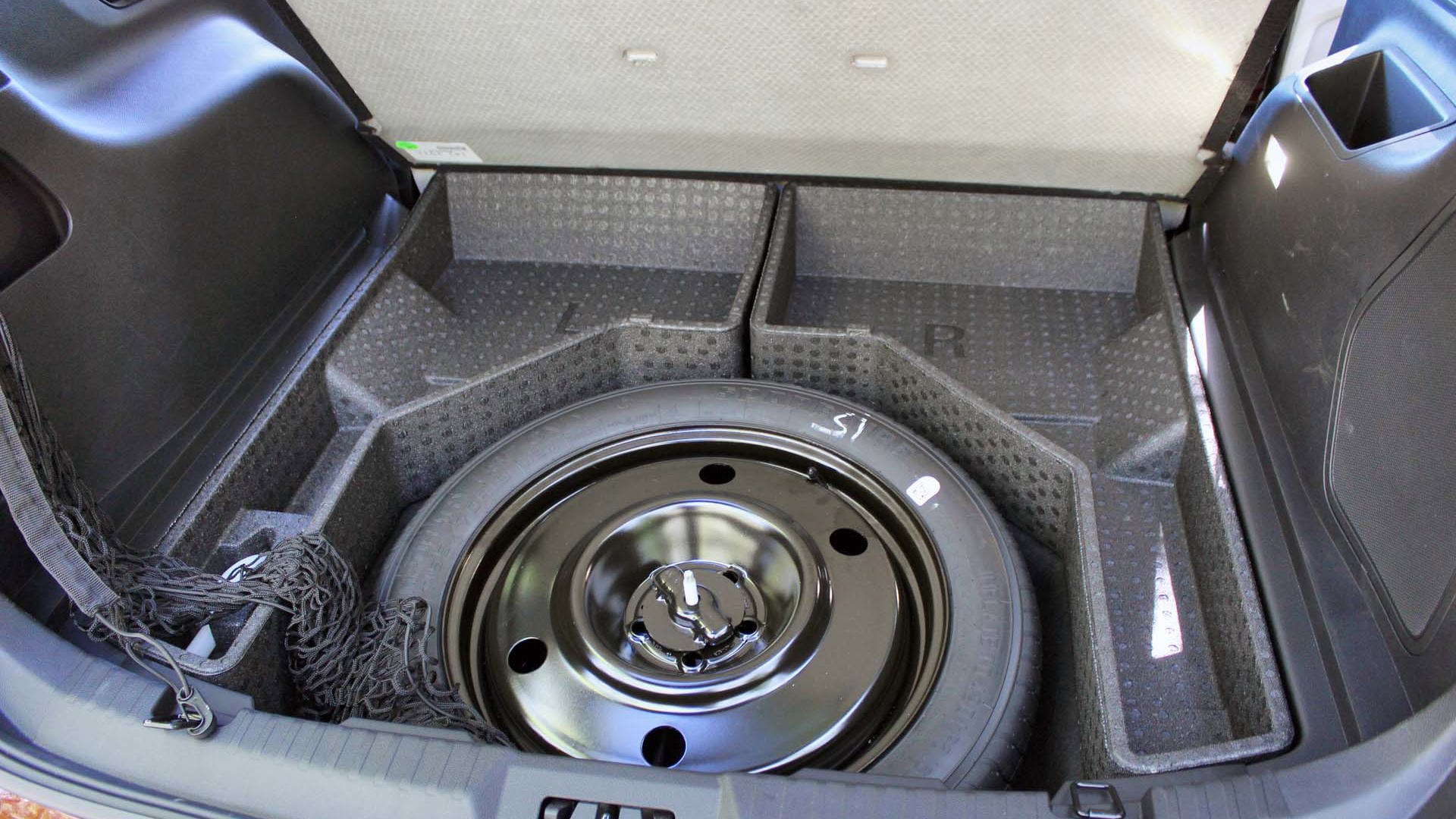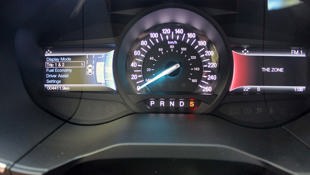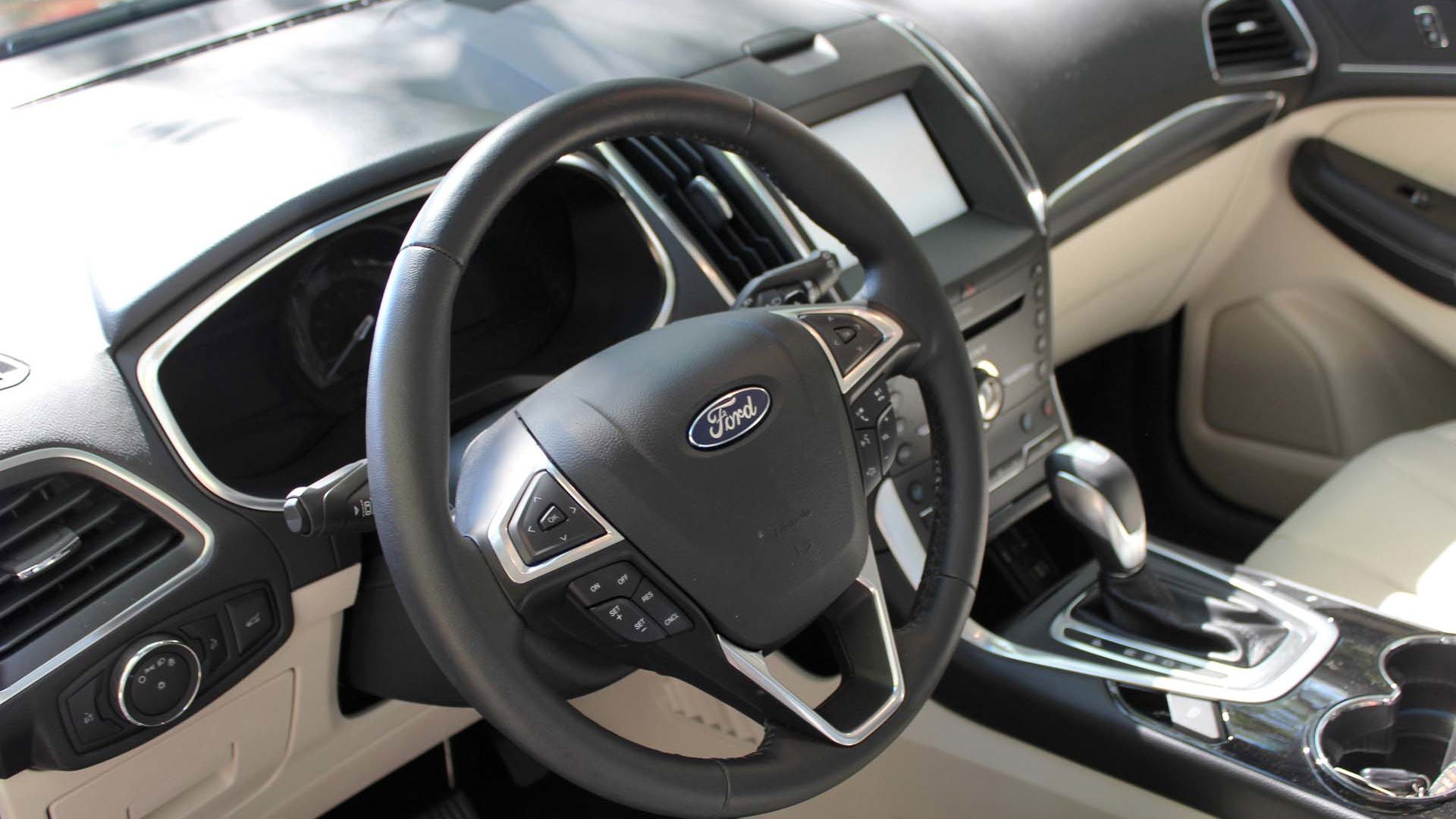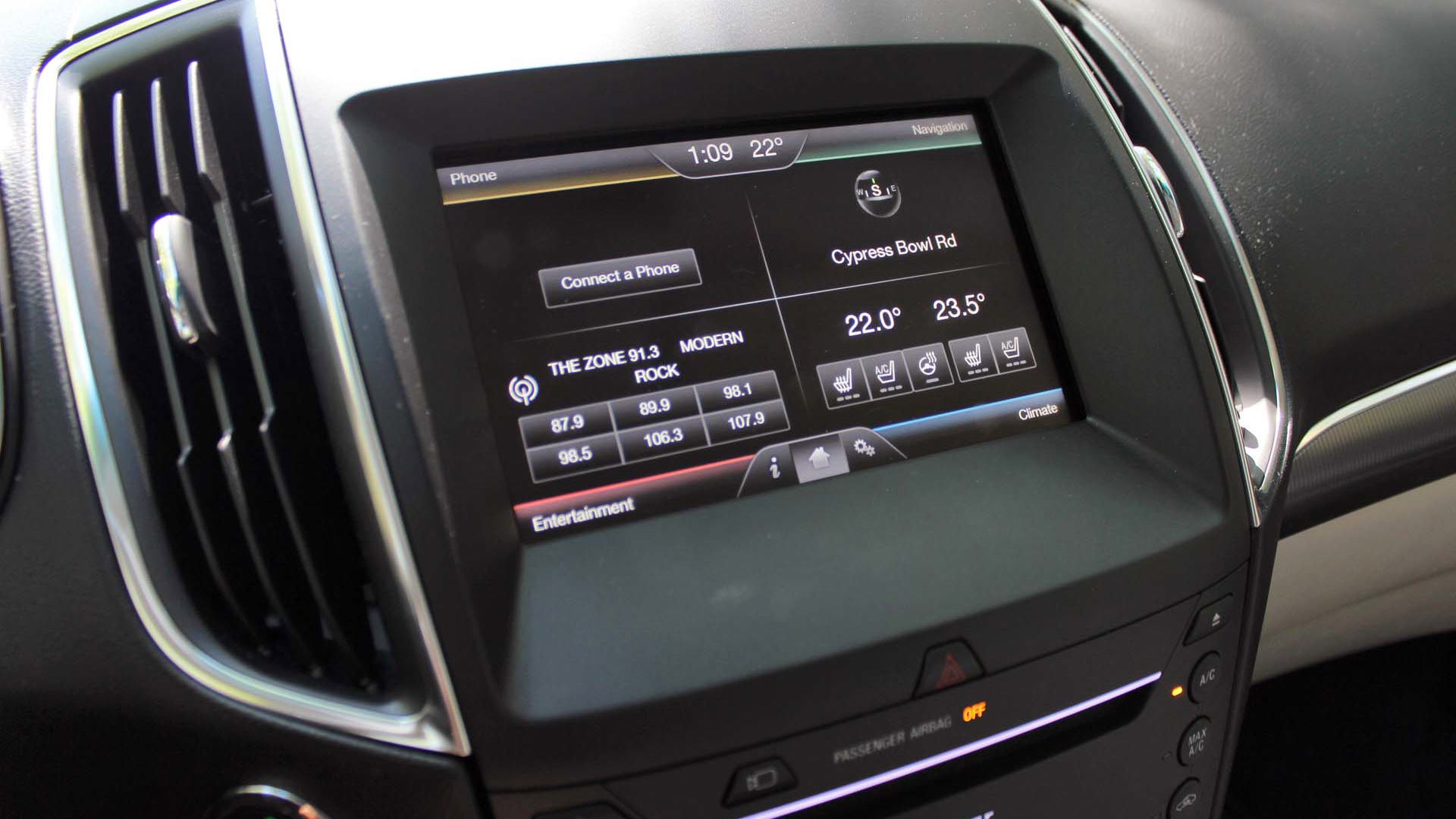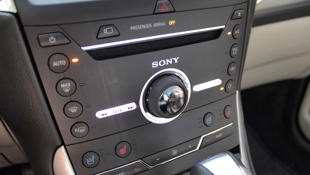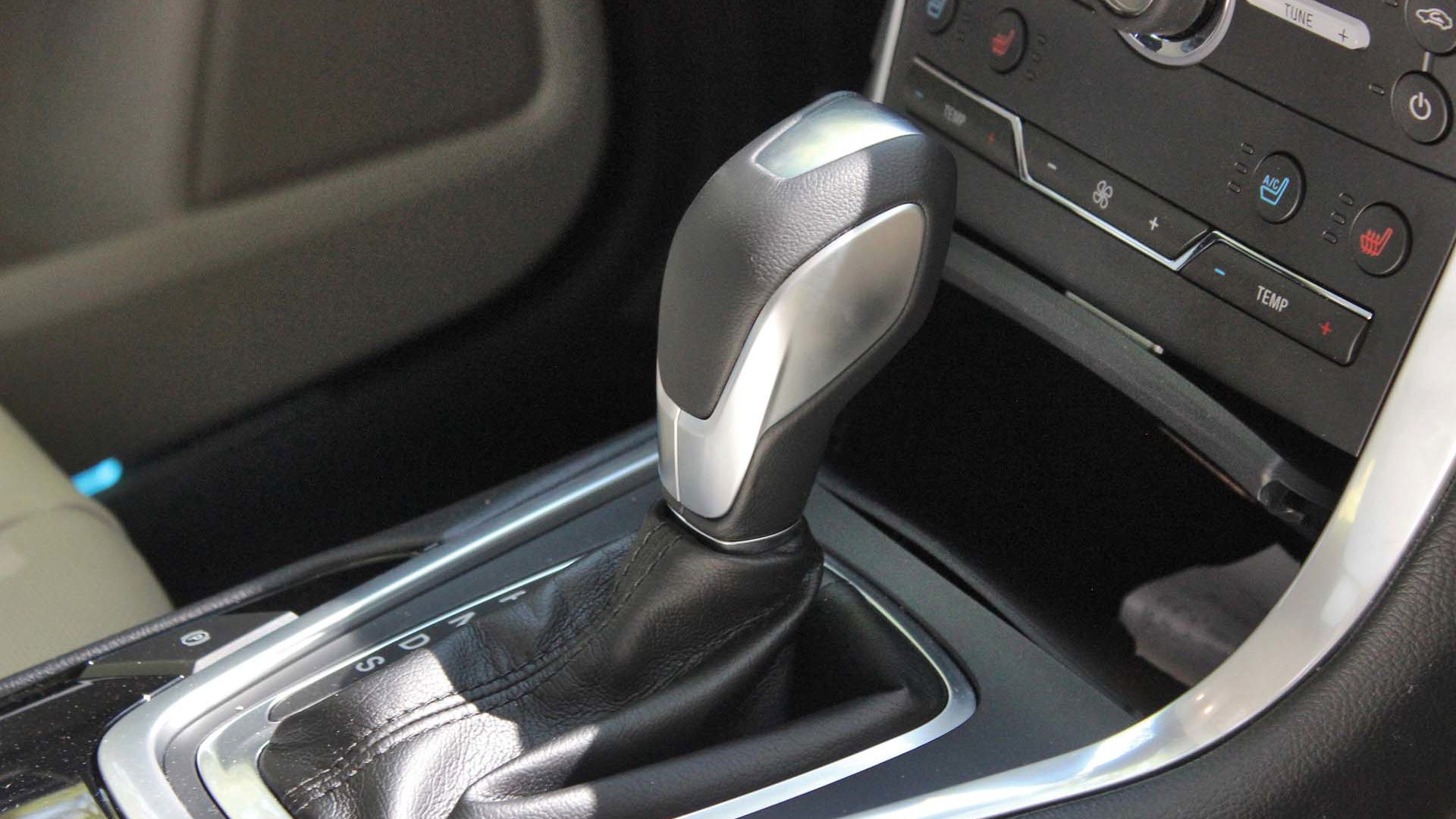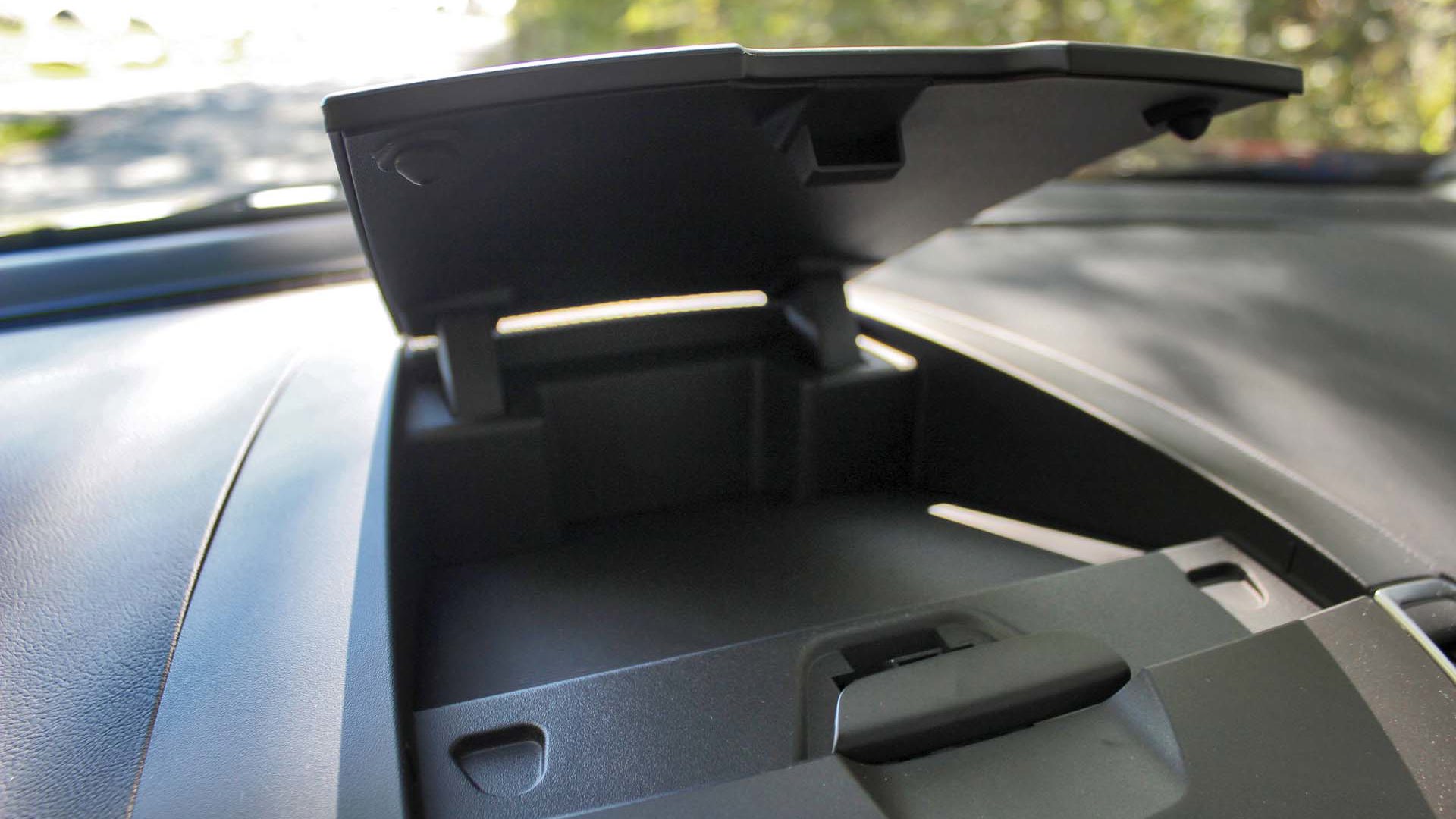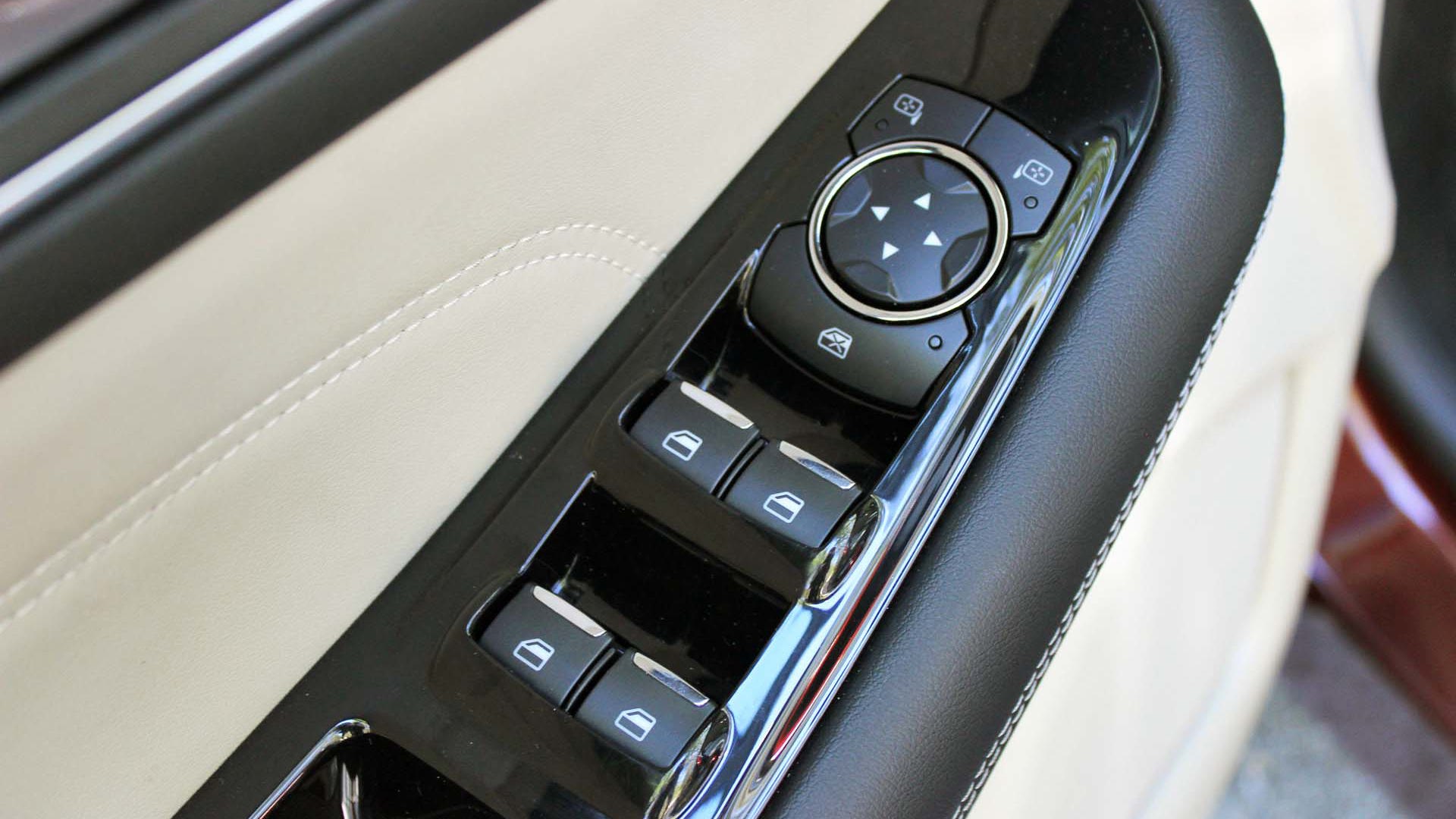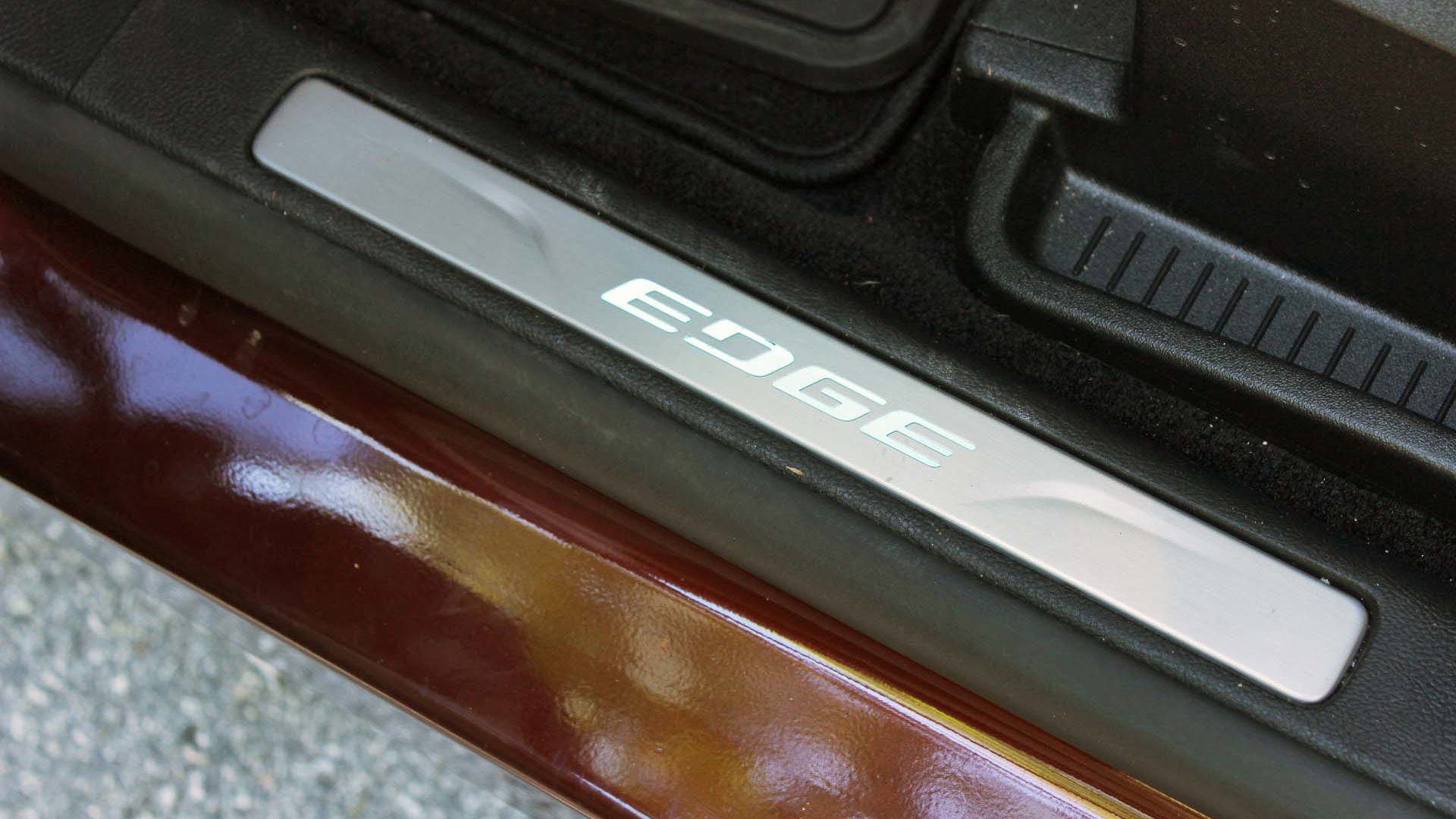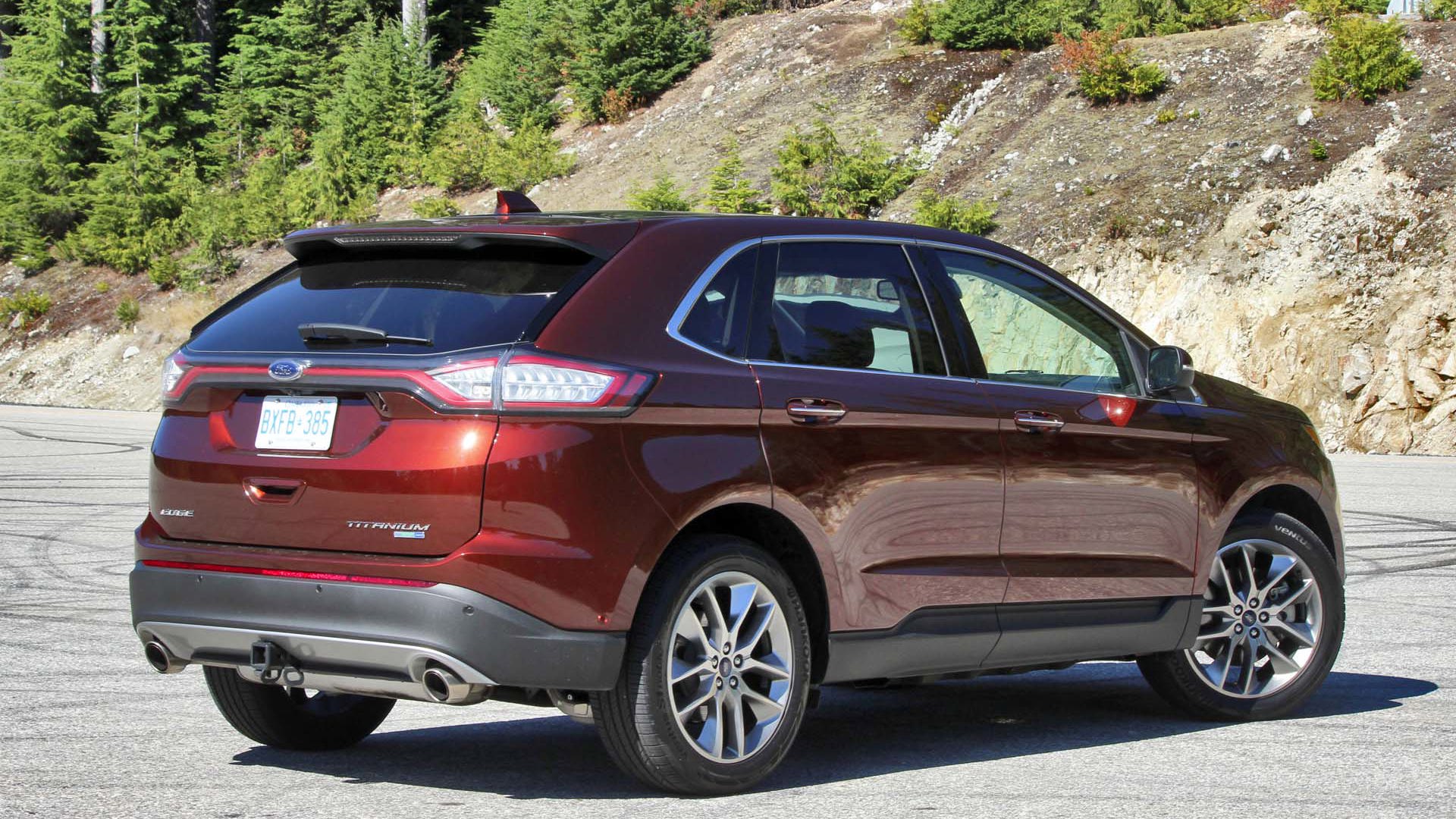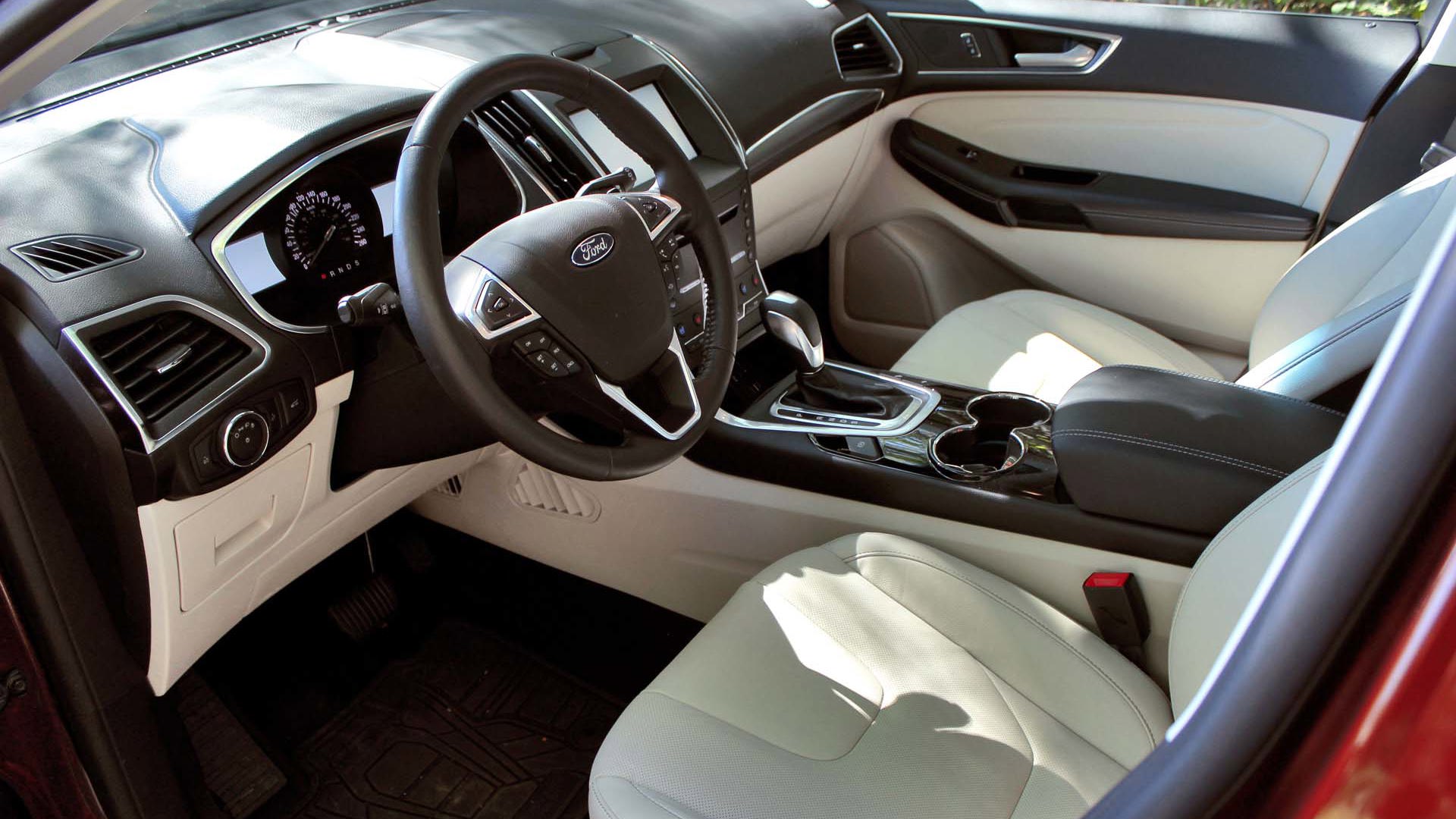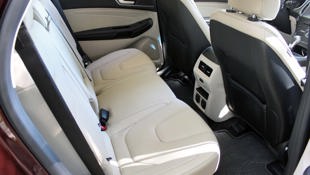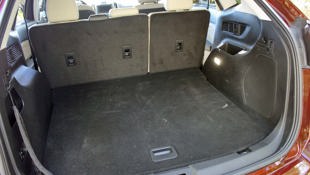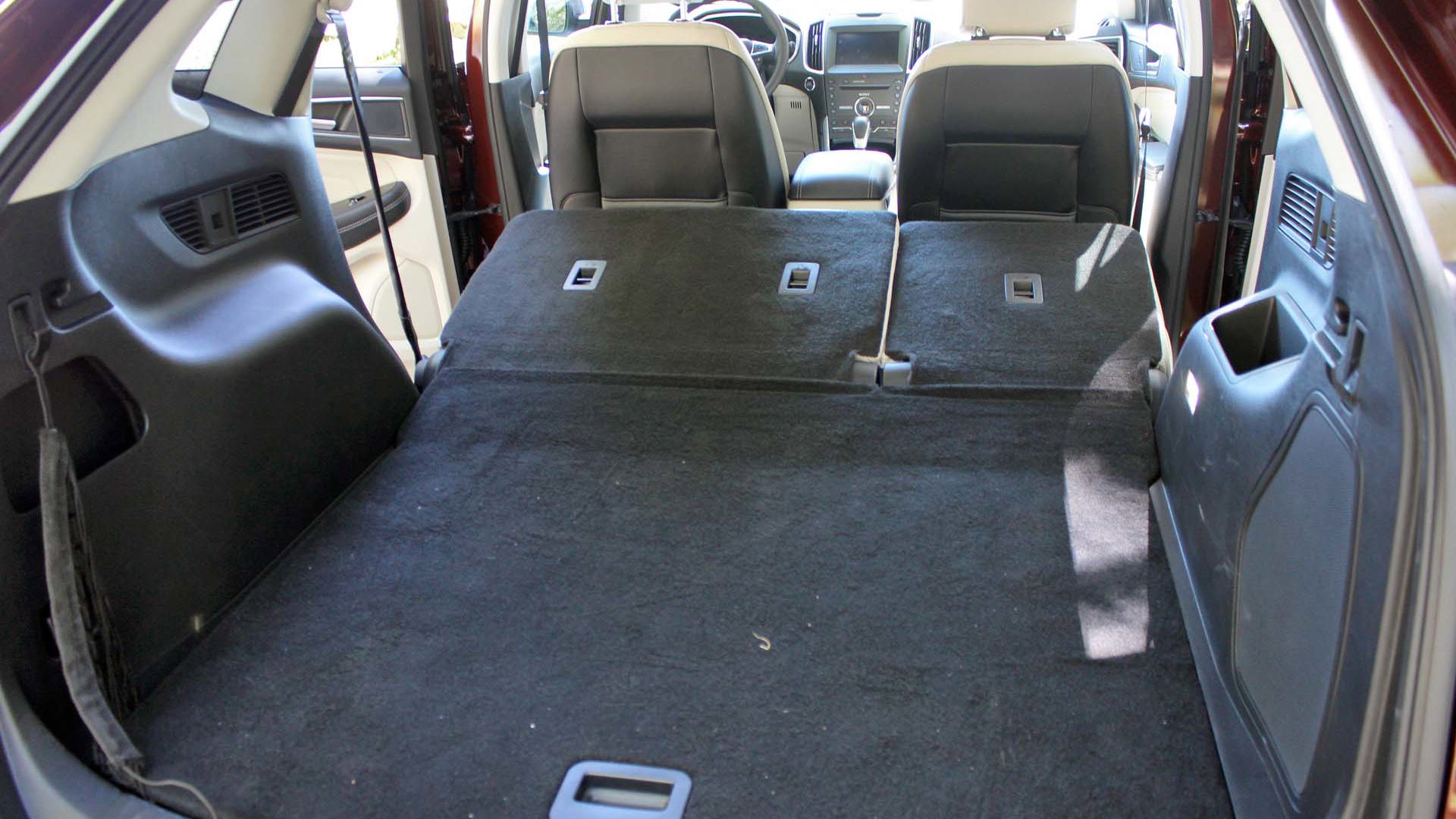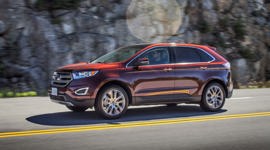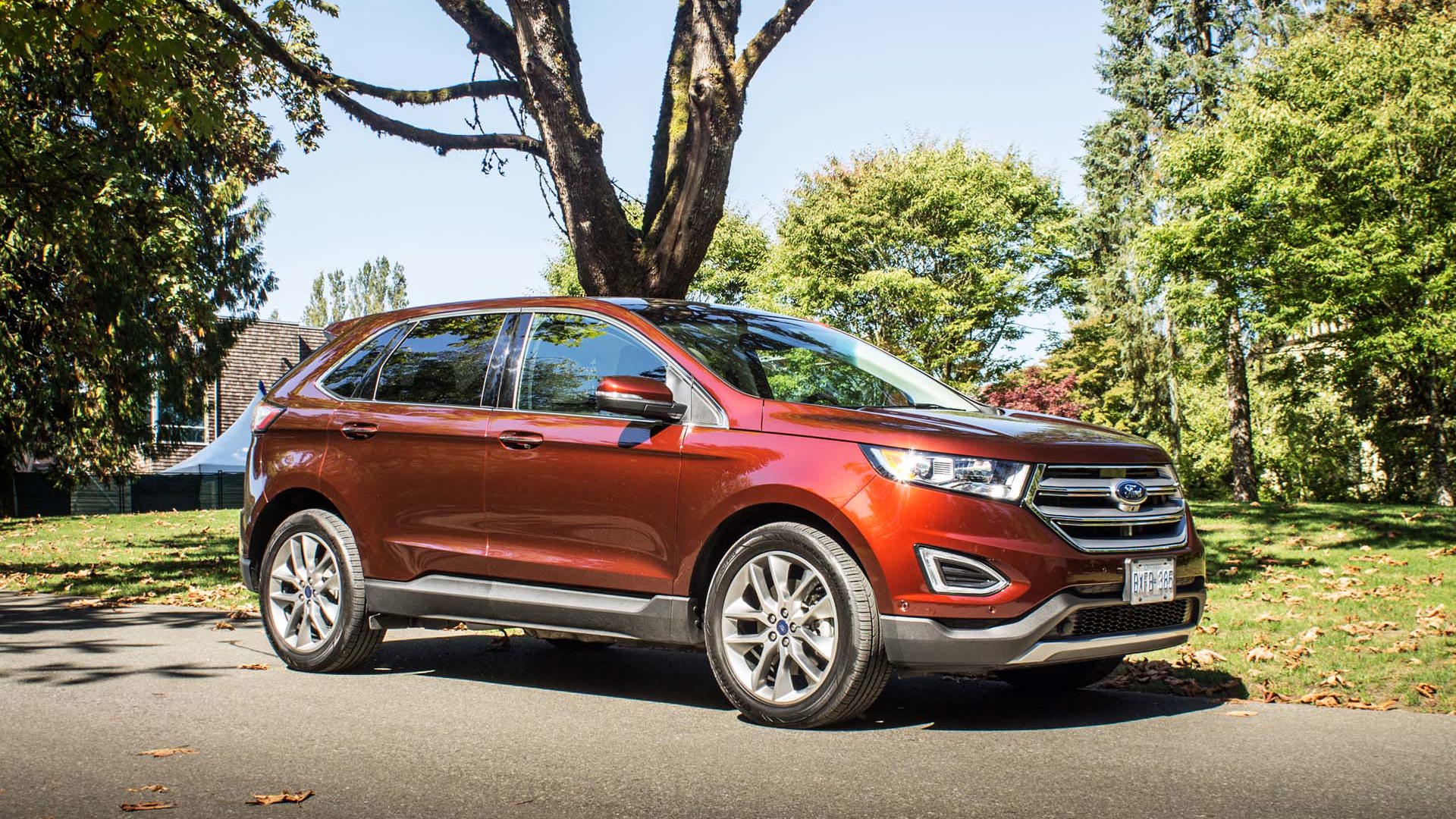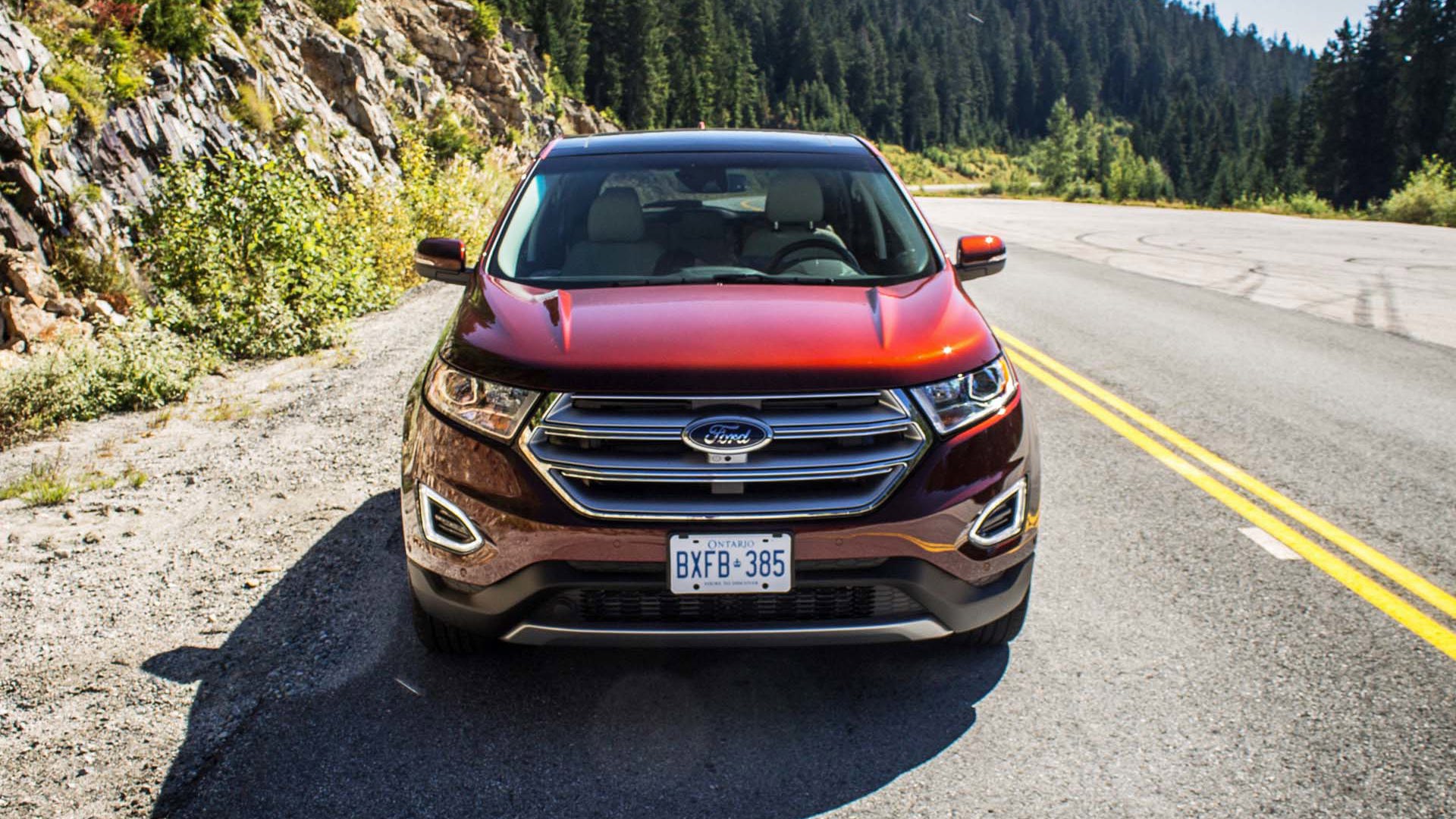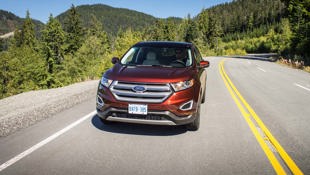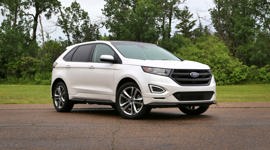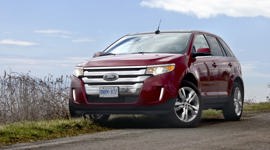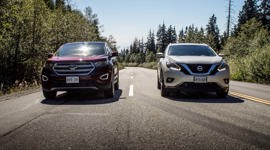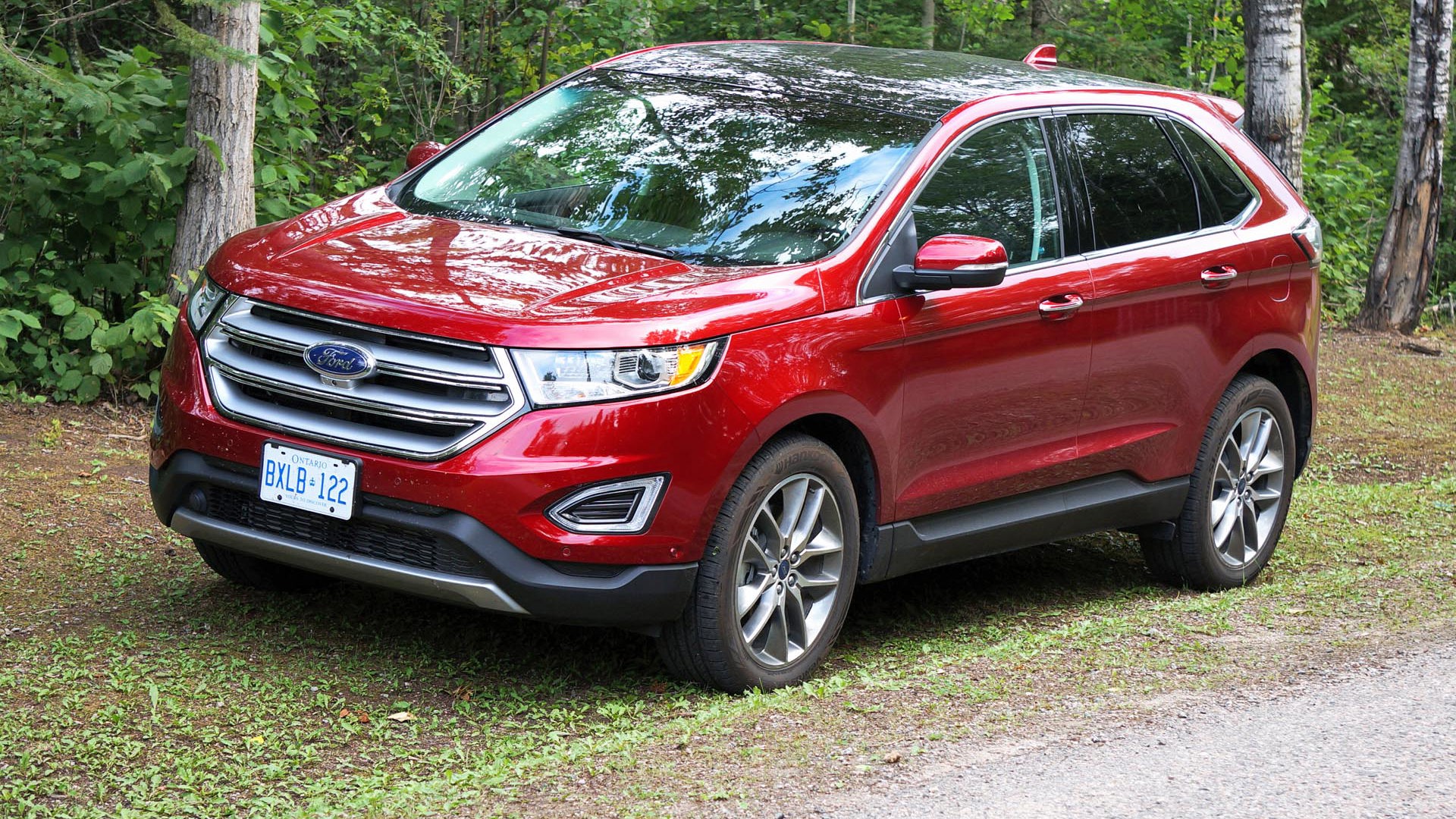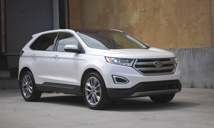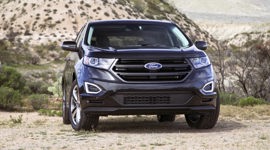 AutoTrader SCORE
AutoTrader SCORE
-
COMFORT8/10
-
PERFORMANCE8/10
-
FUEL ECONOMY6/10
-
INTERIOR8/10
-
EXTERIOR STYLING7/10
Review by Dan Heyman, photos by Dan Heyman and Brendan McAleer
I guess you could say the Ford Edge had a bit of a tough birth. I mean, when your bigger sibling – the Explorer – has been a perennial bestseller, and has been credited with being one of the pioneers of the massive SUV movement, well, “big shoes to fill” is putting it mildly.
A new Edge comes out, and you can pretty much configure it any way you see fit.
Thing is, and to its credit, the Edge was a bit of a pioneer itself. After all, if the Explorer has to be credited for helping usher in the SUV era, then surely, the Edge has to be credited for ushering in the crossover era. Yes, you could argue that vehicles like the AMC Eagle were the true pioneers – you know, take a family wagon (the Concord, in AMC’s case), jack it up a little, and give it four-wheel-drive. Thing is, that segment continues to exist with stuff like the Volvo S60 Cross Country or Audi A4 Allroad; aren’t those the true successors of the Eagle? With that divergence in mind, we can see how the Edge deserves its praise as a pioneer of sorts.
For 2015, the Edge gets new styling, a new engine choice, a new trim level and new drivetrain combinations that should appeal to a broader audience. One of them in particular is the one that underpins the example you see here: the 2.0L EcoBoost turbo-four. The Edge has been available with the engine before, but you could only have it if you were OK with front-wheel-drive, as it wasn’t available with AWD. Indeed, during the launch of the previous-gen Edge 2.0L in late 2011, the biggest complaint – especially amongst the Canadians on-hand – was the lack of an AWD/2.0L option.
Well, it appears Ford took heed, because lo and behold, a new Edge comes out, and you can pretty much configure it any way you see fit, with the 2.0 being available on every trim except the Sport; that one gets a new engine all its own: the 2.7L EcoBoost shared with the F-150.
In keeping with the rest of Ford’s lineup, the styling has been updated and the Edge now gets what was originally called “the New Face of Ford”; however, that was a while ago, so now “the face of Ford” will do just fine. Both the headlights and the grille now get a lower profile, the latter’s six-point shape much less in-your-face than the massive number on last year’s model, even if it does look a little Hyundai Tucson-ish . The rear end, meanwhile, gets a somewhat Lincoln-esque full-length light-bar which is a whole lot more distinctive than what we saw last year. It’s actually a much sharper-looking rear fascia, as last year’s car’s taillight lenses were so small that it made the metal expanse of the rear hatch appear unfinished. Now, everything is nicely tied together.
Inside, the changes aren’t quite as marked, but since our tester was a Titanium model there are plenty of nice materials and pleasing surfaces to behold. The soft leather seats and door inserts are all nice touches but it’s the centre stack that’s the real star in my eyes and it has little to do with materials whatsoever.
More on autoTRADER: Comparison Test: Compact Crossover SUVs
For 2015, they’ve replaced the touch-heavy interface from the old model with proper, traditional buttons for the seat heating (and cooling) controls, audio volume and source, and all of your climate controls. It’s so nice to not have to search and prod the stack for 30 seconds just to boost your fan speed; it’s safer and it’s faster.
Other nice interior additions include thinner seats in order to provide more rear legroom, newly-shaped windows for an airier interior and Platinum and Sport models get a full-length moonroof option, too.
I’d say it’s mostly a nice place to be, if only the driver’s seat position was a little better. It’s fine height-wise, but I just found the strange way the wheel angles away from the driver to be hard to neutralize, no matter how much I played with the telescoping steering column. It’s especially a problem when you suffer from what I call “T. rex syndrome”: long legs, short arms. That means I have to move the seat further back, making the strange steering wheel angle all that much tougher to take.
Rear seat occupants, however, should have little to complain about. There’s 1,030 mm of rear legroom, while the 1,023 mm of rear headroom makes it feel genuinely cavernous in the back, a feeling that’s amplified by the moonroof. Rear occupants should have no trouble travelling long distances in the Edge.
The rear seats fold almost completely flat, providing 2,078L of storage space, which is more than you’ll get from the Nissan Murano or Hyundai Santa Fe Sport. The 1,111L you get when you keep the second row up ain’t too shabby, either. As a bonus with the Titanium trim, you also get the foot-activated rear hatch release. It works better than I remember it working when it debuted on the Escape, but it’s still not an exact science; it had me standing there doing some kind of strange jig behind my car on more than one occasion.
The rear seat experience can be made even more tolerable by opting for a $747 rear-seat DVD system, although it’s a fairly old school-looking dealer-installed option that is at odds with the modernity found most other places in the interior.
Most other places that is, except for the MyFord Touch with Microsoft SYNC infotainment system. It remains as muddy-looking, slow-moving and chunky as it has for years, which is disappointing. It’s especially disappointing because SYNC3 is on the way. I’ve experienced it, and it’s so good that I put it up there with perennial favourite infotainment systems like FCA’s UConnect system or BMW’s iDrive unit. It’s slick, good-looking and responsive. And our Edge didn’t have it.
It did have the $2,000 Canadian Touring Package which, along with the moonroof, provides a voice-activated navigation system so you don’t have to deal with the small buttons found on the eight-inch touchscreen.
The rest of the tech on-hand, though, is actually pretty good. We talked about the hands-free liftgate, but there’s also active lane-departure warning (if you want it to, the Edge will steer itself back into the lane if it senses you’re drifting), blind-spot warning system, split-view back-up camera and advance park assist.
We’ve seen that last one before, but for 2015, not only can the Edge parallel park itself, it can also pull out of a parallel spot and park perpendicularly, too. That last one is especially handy in tight shopping mall lots or underground parkades, when it can be tough a) to determine if the spot is wide enough for the 2,179 mm (with mirrors) Edge and b) when there are pillars and other obstacles to deal with.
Perpendicular park assist works just like parallel park assist does: activate it by first slowing down, pressing a button, and then inching forward until the Edge senses a spot that’s wide enough. Then, all you have to do is stop, select reverse, and meter out the throttle. Not bad. Not bad at all.
Power from the 2.0L is rated at 245 hp and 275 lb-ft of torque, up five each on the 2014 model. That’s not bad for a little engine, and it does well to mask the not-insignificant 1,850 kg curb weight (AWD models).
Head to head: 2015 Ford Edge Titanium vs Nissan Murano Platinum
Once you get past a little turbo lag and approach the 5,200 rpm. sweet spot, the Edge surges forward; it’s got more power than the V6-powered Murano, and it feels it. Peak torque, meanwhile, comes at just 3,000 rpm, so we were never really left wanting for power. Out tester also came equipped with the class II trailer tow package, allowing for 1,588 kilos of towing. Without the $500 package, you’re left with a 680 kilo rating.
While the Sport model is the one I’d get if I were really considering treating it like the “Mustang of Crossovers” – as it was referred to at launch – that’s not to say the Titanium doesn’t have a few tricks up its sleeve that make it a fairly mean handler, as well.
While you will feel a bit of body roll as the going gets quicker in the twisties, you have Curve Control to rely on to make sure you keep the soft-side down. Basically, it uses an algorithm to take in all sorts of factors – wheel angle, speed, steering angle, etc. – and decides whether you’re going too fast into a corner. At which point, all four brakes are used to meter out the speed. Some may say it feels invasive, but I did not; I found it confidence-inspiring, once you come to the realization that just because the Edge is leaning, that doesn’t mean you’re going to lose grip.
Also helping in this regard, but kind of in the opposite manner, is torque vectoring; while curve control is on-hand to curb understeer, torque vectoring brakes the rear inside wheel to improve turn-in as you enter a corner, helping the Edge to better swivel around its axis.
Power is transmitted via a six-speed automatic transmission that comes standard with a pair of paddle shifters, as well as both an “S” and “D” drive mode. If you select “S” and activate the paddle shifters by tugging on one, you will remain in manual mode until you tell it otherwise. The only time the auto transmission will step in is if you’ve eclipsed the redline, at which point it will shift up for you, but keep the paddles active.
If you activate the paddles while in “D”, they will only remain active if you use them; if you start coasting on the highway, for example, it will revert back to automatic mode. It’s good if you want a temporary burst of acceleration for a passing manoeuvre, for instance, or some engine braking on a steep descent.
Still, though, as is the case with so many paddle shifter-equipped crossovers, I hardly used the items on the Edge. That’s partly because the aforementioned steering wheel-angle issues made them tough to reach, but mainly because I was much more content to sit back and let the Edge Titanium whisk me along in comfort. Which, as it happens, is something it does quite well and a huge part of why these things are just so darn popular.
Explorer? What Explorer?
NRCan Fuel Consumption: 11.5/7.8 City/Highway
Observed Fuel Consumption: 12.2 L/100 km
| Warranty: 3 years/60,000 km; 5 years/100,000 km powertrain; 5 years/unlimited distance corrosion perforation; 5 years/100,000 km roadside assistance Competitors: |
| Model Tested | 2015 Ford Edge Titanium |
|---|---|
| Base Price | $41,119 |
| A/C Tax | $100 |
| Destination Fee | $1,690 |
| Price as Tested | $50,659 |
|
Optional Equipment
$7,750 – Equipment Group 302A (Blind spot monitoring system, remote start, auto-dimming exterior driver’s mirror, heated steering wheel, lane departure warning system, enhanced park assist, split-view camera, HID lights, rain sensing wipers, heated rear seats, heated/cooled front seats, 2nd row inflatable safety belts) $3,800, Canadian Touring Package (panoramic roof, voice-activated navigation) $2,000, Bronze Fire clear coat paint $450, rubber floor mats $150, class II trailer tow package $500, 20-inch wheels $850
|
|
